Gem Stones
A gemstone (also called a gem, fine gem, jewel, precious stone, or semi-precious stone) is a piece of mineral crystal which, in cut and polished form, is used to make jewellery or other adornments. However, certain rocks (such as lapis lazuli and opal) and occasionally organic materials that are not minerals (such as amber, jet, and pearl) are also used for jewellery and are therefore often considered to be gemstones as well. Most gemstones are hard, but some soft minerals are used in jewellery because of their luster or other physical properties that have aesthetic value. Rarity is another characteristic that lends value to a gemstone.
Agate

A unique variety of the quartz family, agate is relatively common and affordable. It has an average hardness of 6.5-7 on the Mohs scale. Agate is known for the multicolored bands that might be likened to tiger stripes or tree rings. This beautiful feature is what makes agate such a popular gemstone. Some evidence shows that agate has been used by Human beings for up to 15,000 years. Today Agate is mined in the United States, Mexico, Germany, Italy, Brazil, China, India, Africa and a number of other countries.
Alexandrite

A variety of the mineral chrysoberyl, top quality alexandrite is very rare and very valuable. At 8.5 on the Mohs scale, its hardness is considered to be relatively good. High quality alexandrite dramatically changes color from green in fluorescent light and daylight to purplish red in incandescent light. Discovered in Russia in 1830 and named after Czar Alexander II, it was soon adopted as the national stone of Russia. Its colors correspond to the Russian imperial colors. Other forms of alexandrite are mined in Brazil, Tanzania, Sri Lanka, India and Madagascar. Alexandrite is also an alternative June birthstone in the United States.
Amethyst
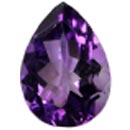
A variety of the quartz family, amethyst is considered to be common and affordable. This colored stone has a hardness of 7 on the Mohs scale, and varies in color from light lilac to deep purple. Amethyst can be very sensitive to heat and sunlight. It may lose all of its color when exposed to strong UV rays for extended periods of time. Amethyst was believed by many cultures to possess various supernatural beneficial properties such as promoting piety and preventing alcohol intoxication. Mined in Brazil, Uruguay, Bolivia, Tanzania, Zambia and Namibia, small amounts are also found in the United States. It is the February birthstone in the US.
Aquamarine

A variety of the beryl mineral, aquamarine is named for its sea-like color, which can range from pastel blue, to deep blue, to greenish or yellowish blue. Deep blue aquamarine stones are considered to be the most valuable of their kind. Aquamarine has a good hardness of 7.5-8 on the Mohs scale. It is frequently used in modern designs and is believed to be a lucky stone in several cultures. It is mined mainly in Brazil, Zambia, Mozambique, Angola, Nigeria and Madagascar, and is the March birthstone in the United States.
Black Onyx

A variety of the quartz family, black onyx is a popular, common and affordable gemstone. This beautiful black stone has a hardness of 7 on the Mohs scale. Although black onyx is known for its deep black color, it may display bands of white. Sardonyx is a form of onyx which varies in color from white, to red or reddish brown. Black onyx can be found in the US, Brazil, India, Pakistan and Madagascar. It is the Zodiac stone for Capricorns.
Citrine
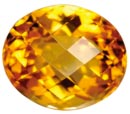
A member of the quartz family, citrine is typically more affordable than amethyst. This bright gemstone has a hardness of 7 on the Mohs scale. Its color ranges from bright yellow to honey and orange-brown. The name citrine comes from the French word for lemon, appropriately describing this colored stone's warm, inviting hue. It is mined in Brazil and Bolivia, where it is common and plentiful. Citrine is frequently exposed to heat enhancement in order to improve or modify its color. It is an alternative November birthstone in the United States.
Coral

Coral is an organic gemstone. Genuine, untreated coral is very rare and therefore very valuable. It is extremely delicate, its hardness measuring at approximately 3.5-4 on the Mohs scale. Coral is composed of calcium carbonate, which is secreted by small sea polyps in order to create their own natural protective habitat. Commercial coral is never harvested from protected reefs or banks, and harvesters have recently become more careful with their harvesting methods, dispatching professional divers to carefully collect coral branches so as to avoid damaging the sea organisms within. Most coral used in jewellery comes from Sicily or Sardinia. Coral ranges in color from reds and oranges to whites and even blues.
Emerald
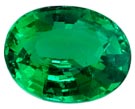
The emerald is a member of the beryl family. It is very rare and commands relatively high prices on the market. Because inclusion-free emeralds are extremely infrequent, the detection of inclusions minimally impacts the value of an emerald, if at all; only very severe and deep inclusions will reduce an emerald's value. The most highly-priced emeralds exhibit a bright grass-like green. Emeralds have a very good hardness of 7.5-8 on the Mohs scale. They are known worldwide for their exquisite green hue and have been embraced by mankind for over 4,000 years. Mentions of emeralds appear in the myths, legends and rituals of the Incas, the Egyptians, the Indian Moguls and the Ancient Greeks. They are believed by many cultures to have positive supernatural powers. Their green color can range from a very light yellowish green to a deep, dark, sometimes bluish tint. Currently, most emeralds are mined in Columbia, Brazil, Zambia, Zimbabwe, Afghanistan and Madagascar. The emerald is the May birthstone in the United States.
Garnet

Garnet is the name of an entire family of stones that can be found in a wide spectrum of colors. The value of any garnet depends entirely on color, size and corresponding rarity. While deep red is the most common, affordable and traditional garnet color, garnets may range from green, orange, and yellow to earthier sepia hues; they come in almost every color, other than blue. Garnets have a good hardness of 7.5-8 on the Mohs scale. These gemstones have been valued by mankind for thousands of years and are mentioned most famously in the story of Noah's Ark. Garnets in common colors hail from India, Sri Lanka, Thailand, South Africa and the United States, while the more exotic garnet colors are mined in East Africa and Russia. The garnet is the January birthstone in the United States.
Jade
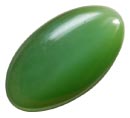
Jade is an umbrella term for two stones: jadeite and nephrite. Jadeite displays colors which include green, white, pink, red, black, brown, and violet. Nephrite typically displays mid to dark green or gray-green, but it can also be white, yellowish, or reddish. Only the finest jades have evenly distributed color. Jade has been valued by both Eastern and Western countries for over 7,000 years. It is considered an especially precious symbol of royalty, compassion, goodness, beauty, modesty and more. Jades have an average hardness of 6.5-7 on the Mohs scale, but they are extremely tough. Because of this toughness, jades have been used by early civilizations to make knives, axes, tools and weaponry. They are well known for being an effective remedy for kidney ailments. The word jadeite originated from the Spanish 'piedra de ijada', and the word nephrite originated from the Latin' lapis nephriticus', both meaning 'loin stone.'
Lapis Lazuli

Lapis Lazuli has been used for over 6,000 years as an ornamental gemstone, and is known worldwide for its breathtakingly deep blue color. The name of the stone is a combination of Latin and Arabic words meaning 'blue stone.' Lapis Lazuli has a hardness of 5-6 on the Mohs scale; it is sensitive to extreme conditions, but can also be ground into a powder as a base for watercolors, oil-paints and tempera paints. This beautiful stone is believed to symbolize friendship and truth.
Moonstone
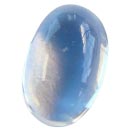
Moonstone is a member of the large feldspar family of minerals which includes about two-thirds of all stones on earth. It has a hardness of 6-6.5 on the Mohs scale, and exhibits a wide range of colors from green, brown, yellow, gray pink, rainbow, and colorless to very rare blues. High quality moonstones display a bluish luster. Generally thought to resemble moonshine, the token characteristic of the moonstone is its white shimmery glow. History holds that the Romans and Hindus thought the stone was formed from actual pieces of moonlight, and many still believe that the future may be seen in its ethereal glimmer. The unique blue-glow of light that slides across the surface of the stone is caused by a type of light refraction called adularescence. Most moonstones come from Sri Lanka, but some are mined in India, Burma, Mexico and Madagascar. The moonstone is the June birthstone in Europe.
Opal

The word opal originates from the Greek 'opallos,' meaning ' color change,' referring to the color of the opal which seems to vary when tilted under light. This phenomenon occurs due to an internal diffraction of light which disperses a spectrum of iridescent colors. The opal family is well known for its special rainbow color play, and is available in an almost infinite array of hues including black, white, colorless, yellow, reddish, green, blue and multi-colored. The opal has an average hardness of 5.5-6 on the Mohs scale. A myriad of superstitious legends exist regarding the origin of opals and the supernatural powers that these stones may possess. The main origin of the opal is Australia, with Mexico and the US serving as its secondary sources. Opal is the October birthstone in the United States.
Pearl
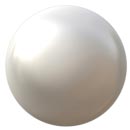
The most valuable of all organic gemstones, pearls are created when an oyster senses an irritant within its soft shelled mouth and then coats it with layers of nacre. Today, almost all pearls on the market are cultured by artificially introducing a small bead or shell into the mouth of an oyster. The majority of pearls are cultured in Japan, but many are harvested in China and the South Pacific. Pearls range in size, shape and color: some are large, round and white while others are small, amorphous, and black. Pearls have always been considered classic gemstones, symbolic of beauty and dignity. The pearl is the zodiac gemstone for Cancer. Learn more about pearl types and characteristics in our Pearl Education pages.
Peridot
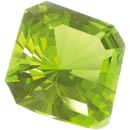
A member of the olivine family, peridot comes in a variety of shades of green. The signature lime-green peridot is a characteristic of the mineral itself, rather than that of a foreign element. Peridot is one of the sole gemstones that can be found in only one color. It has a hardness of 6.5-7 on the Mohs scale. It is believed by some that peridot enhances the effectiveness of any medicine. According to others, peridot protects against nightmares. An indigenous Hawaiian myth suggests that a peridot stone is a tear of Pele, the Hawaiian fire and volcano goddess. Most peridot is mined in Arizona; other sources being China, Burma, and Pakistan. Peridot is the August birthstone in the United States.
Ruby

Ruby is the red manifestation of corundum; all other colors of corundum are referred to as sapphire. Due to its durability, brilliance and bewitching red color, it has for thousands of years been considered to be one of the most valuable gemstones. Larger rubies, being rarer, command the highest prices. This precious gemstone has a very good hardness of 9 on the Mohs scale. Owing to its red color, the ruby is commonly associated with passion, love, power, warmth, blood, and fire. Rubies have been worn by warriors to give them courage, by kings to give them power, and have been gifted as an expression of undying love. The highest quality rubies exhibit a deep vivid red or purplish red. The ruby is the June birthstone in the United States.
Sapphire
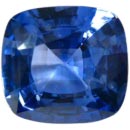
Sapphire is a member of the corundum family. Sapphires most commonly occur in blue, and vivid, pure, deep blues are the most valuable. For thousands of years, sapphire has been associated solely with the color blue, its name originating from the Greek word 'sappheiros', meaning blue. However, sapphires can be found in every color besides red, as red sapphires are called rubies. Throughout the course of history, this gem has been worn as a protective amulet, as a symbol of harmony, loyalty and friendship, and as a romantic token. The stone has a very good hardness of 9 on the Mohs scale. Sri Lanka is the biggest producer of sapphires, but they are also mined in Kenya, Burma, Tanzania, Kashmir, Madagascar, Thailand, Vietnam, Cambodia, Laos, Australia, and the United States. The sapphire is the September birthstone in the United States.
Tanzanite

A member of the zoisite family of minerals, tanzanite is found only in shades of blue or purple, the most popular being a violet-blue. While tanzanite is typically heat treated to enhance its blue color, it is naturally trichroic, meaning that it displays three different colors (blue, purple and bronze) when viewed from different angles. Tanzanite exhibits a hardness of 6.5-7 on the Mohs scale. It gets its name from the country of Tanzania, the only place in the world where it is found. Tanzanite was discovered as recently as 1967, and was christened by colored stone experts to be "the gemstone of the 20th century." Owing to its fast growing popularity, the American Gem Trade Association added it as an alternative December birthstone in the United States in 2002.
Topaz
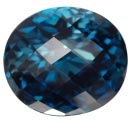
Topaz is one of the most common gemstones worldwide. It has a very good hardness of 8 on the Mohs scale. Topaz comes in a rainbow of colors, the most valuable of which are the red, pink and orange stones which are mined in Brazil, Pakistan and Russia. Colorless topaz is mined in Sri Lanka, Nigeria and China. Blue topaz is colorless in its rough form, and takes on its blue hue only after exposure to irradiation enhancement. It is quite sensitive to heat and sunlight, and may lose all of its color when exposed to strong UV rays for extended periods of time. Many cultures have claimed that topaz has mythical and magical strengthening powers. It is the traditional November birthstone and the alternative December birthstone in the United States.
Tourmaline
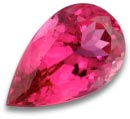
The word tourmaline was derived from the Sinhalese words 'tura mali,' meaning 'mixed colored.' As its name indicates, tourmaline is found in a vast array of colors and color mixtures, more than any other gemstone in the world. For this reason, no two pieces of tourmaline are ever identical. Since many of its colors look similar to the colors of other gemstones, many tourmaline stones have been misidentified as rubies and sapphires. This colorful gem exhibits a good hardness of 7-7.5 on the Mohs scale. The rarest colors, which include copper and electric blue, are the most valuable. Many magical powers have been attributed to tourmaline over the ages, including the power to enhance artistic creativity. Although Brazil is the most common source of tourmaline, the stone is also mined in Tanzania, Madagascar, Australia, Sri Lanka, the United States, and Russia. It is an alternative October birthstone in the United States.
Turquoise
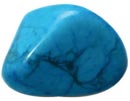
A member of the copper family, turquoise is one of the oldest gemstones known to man, having been treasured by countless ancient civilizations across the globe. It is thought to have originated in Iran, where many Persians wore turquoise on their turbans to protect against the evil eye. Native Americans, Egyptians, Chinese and Tibetans also believe turquoise holds spiritual and protective powers. Turquoise is known for its light blue color, which can range from greenish-blue to sky blue, and at times exhibits yellow, black, gray, or even brown veining. This renowned gemstone exhibits an average hardness of 6 on the Mohs scale. As Iranian sources of turquoise have been nearly depleted over the centuries, the stone is now mined mainly in the southwestern United States, Mexico, Afghanistan, Israel and China. Turquoise is the December birthstone in the United States.

